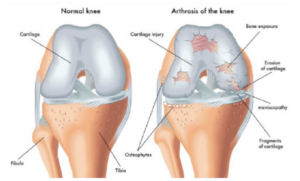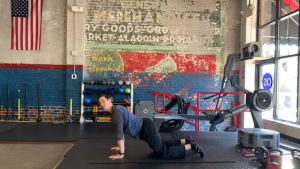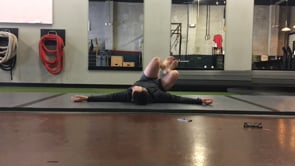Arthritis! We’ve all heard of it.
But what is it and how do we avoid it?
Understanding Arthritic Joints

Arthritis, or specifically osteoarthritis, is a wearing down of the cartilage in our joints.
Articular cartilage, also called hyaline cartilage, is the cushion that covers our joints. It is bathed in synovial fluid for nutrition and lubrication. It stays healthy and receives its nutrition through “diffusion”… which is what happens when you put weight through a joint. The pressure from your body weight squeezes the water
and other fluids out of the cartilage. When the weight is removed, the tissue re-absorbs water and nutrients. This process is how cartilage eats, drinks, breathes and poops… or how it stays healthy.
Articular cartilage forms primarily during our childhood, ending in early adolescence. Generally speaking, once we’ve hit the end of adolescence, what we have is what we’ve got. So be kind to it and keep it healthy!
How? We’ll touch on that in a bit, but know that if articular cartilage is damaged, the body will try to heal it. The body will heal the damaged cartilage with a different type of tissue that does a poor job in taking the place of the damaged hyaline cartilage.
This regenerated tissue will eventually fail, and this roughening or wearing down of the smooth surface covering the bone is arthritis.
Combatting Arthritis
Arthritis is the most common form of joint disease.
To date, there is no disease modifying drug on the market that can stop this process, and surgical repair is notoriously difficult and usually only ends in further surgeries. Articular cartilage also has no nerve endings or blood vessels, so it doesn’t hurt or bleed when it is damaged.
So how do we keep our joints (the cartilage, specifically) healthy if we don’t know that it is even hurt or wearing down in the first place?
The answer to keeping healthy joints is through repeated “compression, decompression, compression, decompression …”.
Walking is a perfect example of this and is extremely beneficial for our hips, knees and ankles.
 Rocking on our hands and knees is also a great way to produce this compression-decompression effect for our wrists, elbows, shoulders, hips and knees!
Rocking on our hands and knees is also a great way to produce this compression-decompression effect for our wrists, elbows, shoulders, hips and knees!
Rocking also puts less body weight on our hips and knees then when walking, so rocking can be a great way to work up to walking.
If you have arthritis in your back, the joints in our lower back are vertically oriented, so need a different motion…

Rotation will get that same compression-decompression effect in our lower backs. So for lower back arthritis, try some twisting, like the windshield wipers (pictured left), or rolling over like a worm! (No “log rolling”, as that has very little twisting involved.)
But, Ouch, getting on my knees hurts
If you’ve been avoiding things like kneeling, crawling, or rocking because the front of your knees are tender, then it’s time to start on a thicker cushion, mat, pillow, or something like a bed or couch. No need to get on the hard ground, although if you’re able, it’s a great option.
Start by getting on your hands and knees onto your bed, maybe crawl a few steps forward and back, breathe into your belly and nod your head up and down or side to side.
You are trying to stay relaxed and not let your body go into its pain response, or fight-or-flight response. Once you can tolerate a couple of minutes on your hands and knees while staying relaxed, then introduce some small forward and backward rocking.
If it starts to hurt, stop.
Listen to your knees (or hips, or wrists, or shoulders…). They will tell you when enough is enough.
Cliffnotes recap:
For that lower back or hip/knee arthritis, try some rocking, walking, rolling and twisting. Don’t stop moving and being more sedentary, give those joints what they need, but stimulating compression and decompression of the joint which stimulates lubrication of the joint and will provide noticeable improvements.
Need further direction?
If you need more specific answers to your individual issues, feel free to ask your local OS Certified Pro, drop by the physical therapy room at OS Institute, or set up a tele-health appointment with Dr Kurt. You can also shoot us an email at drkurt@os-institute.com.
